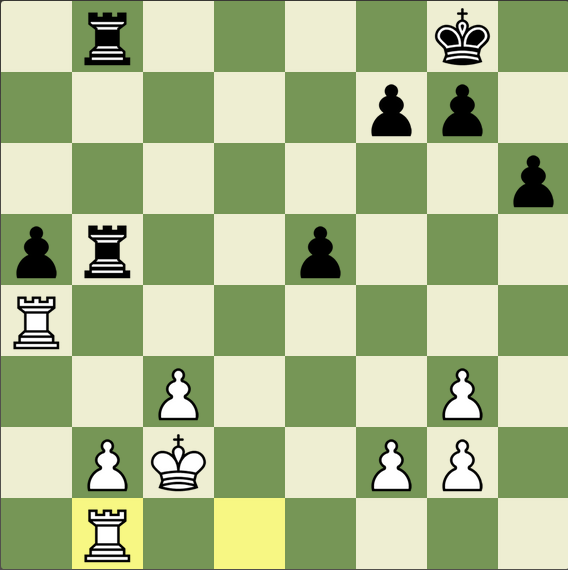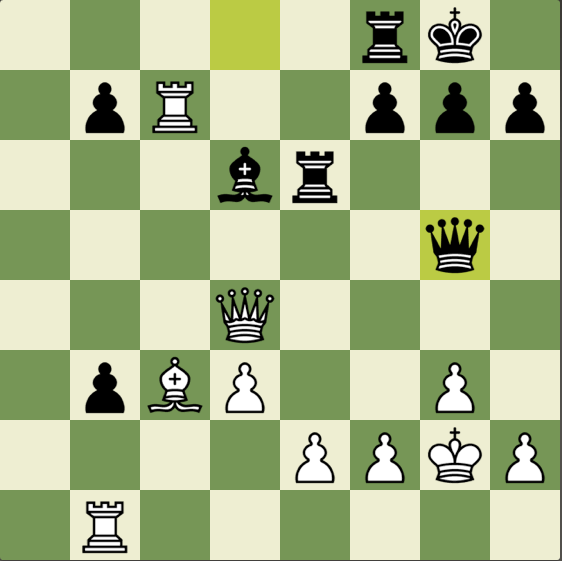After a tough stretch in the middle of the Southwest Class, I had 4/6 but still had a 2600+ FIDE performance. I have played enough GMs, titled players, and foreigners to satisfy the technical requirements. “All” that was left was good play and some luck. 2/3 or 2.5/3 in the last three rounds would get me a GM Norm. Deep breath.
In round 7, I got white against IM Zurab Javakhadze (2430 FIDE, 2504 USCF). This game was, in a nutshell, not what I was expecting…

Up to this point, everything was relatively normal. 11… f5 doesn’t work on account of 12.exf5 Rxf5 13.g4, but black could choose to play 11… Bxf3 12.Qxf3 Nd4 13.Qd1 c6 14.Ba2 Bg5 or 11… Nd4 12.g4 Nxf3+ 13.Qxf3 c6!, after which white doesn’t have much. Instead, my opponent played the seemingly natural 11… Qd7?? running into the Puzzle Rush tactic 12.Nxe5!

I had seen this one coming for a while. Black is losing a pawn no matter what he does. On top of that, it’s a strong central pawn, and white will also have the bishop pair afterwards. I think it’s totally reasonable to say that black is just lost here.
I can’t remember the last time I had a winning position after only 12 moves, and especially against an IM… How much more luck could go my way??
CHESS SUPERSTITIONS
If I didn’t venture into the world of chess superstitions, this article would be a scam. Before this tournament, my personal chess superstitions didn’t really go beyond the realm of lucky pens. The pen I was using this tournament hadn’t served me so well before but was now doing an excellent job. I so wasn’t going to change it. There was, however, the possibility of using my lucky shirt.
The World U16 Olympiad in November was a rough tournament for me to say the least, but there was one highlight: beating the top seeds Uzbekistan in a huge upset. I therefore used the same logic I have with lucky pens to wear the same shirt I was wearing that match for the last day, when I sure wanted a bit of luck…
In round 8, I got black against GM Kamil Dragun (2589 FIDE, 2668 USCF). I didn’t back down at all, and I’m really glad I did that. Unfortunately, my nerves weren’t the problem—my brain was…

I had just scraped out of some complications—and a bit of trouble—to reach this position, which really didn’t seem that dangerous. However, white a) has the d-file, b) can get his pawns moving more easily on the kingside, and c) can possibly tie black down to the a-pawn. Still, after a reasonable plan of action like 26… f5 27.Ra4 Re7, black should be holding his own.
Instead of playing on the kingside, however, I decided to play on the queenside and tie white’s pieces down there. That really didn’t work out. The game went 26… Rb8 27.Kc2 a5 28.Ra4 Rcb5 29.Rb1

Ok, what next…? White will simply play c4 and start pushing black back. The best course of action here is still to play 29… f5! 30.c4 Rc5 31.Kc3 Kf7 32.Rba1 Ra8, after which black is a bit worse but things aren’t too bad. Instead, I went for more counterplay with 29… Rd5, which just turned out not to work. After 30.c4 Rd4 31.Kc3, I realized that 31… Rbd8 32.Rxa5 Rd3+ 33.Kb4 isn’t so great for me, though after 33… f6! black can still put up resistance. I backed down with 31… Ra8, being under the illusion that I could save the a-pawn. After 32.b3 Re4 33.Ra1 Re2 34.Rxa5, I found myself totally busted. I threw in the towel a few moves later.
Did I just ruin my GM norm? I should’ve crawled into a hole after this, but I didn’t. I just… brushed this off.
Now for some drama. My performance dropped below 2600, but the norm wasn’t gone. I needed to beat a 2400+ opponent to get my performance back above 2600. But would I even get to play such an opponent? I honestly didn’t really care. Yes, I did want to get such a pairing, but I wasn’t stressed out. Here are a few reasons…
- My rating is still far away from reaching 2500; if I were 2490, it would have been a totally different story…
- There’s no doubt in my mind that on the way to 2500, I’ll have my fair share of norm chances if I keep playing like this
- GM won’t be the end of my chess journey—it’s just a step on the way up, though a huge step at that.
As the wallcharts for round 8 were incomplete, it was impossible to figure out whom I would play; the best I could do was to make educated guesses with the incomplete results at hand. And as it is often the case with the last round, the pairings didn’t come up until after the round was scheduled to start. I did the only reasonable thing—I prepared for a couple players whose ratings would give me a shot for the norm. And in the end… I got lucky with the pairings: I was white against IM Kacper Drozdowski (2490 FIDE, 2562 USCF). This was the third time when I was in a situation where I needed to win to get a GM Norm, the first time was at the Philly Open in April 2017 and the second time at the Washington International in August 2018. I had lost both times before, but this game was different…

The opening had gone well for me, as I had established a solid bind in the center and was already going on the offensive with 14.g4. Black is already in a tight spot here. Attempts to lash out with 14… g5 won’t work: white has 15.Qh3 or even 15.Nd5! (with the idea 15… exd5 16.Nf5 with a strong attack). 14… h6 15.h4 g5 is even riskier. Black’s best chance may be to sit tight with 14… g6, but that doesn’t look pleasant…
Instead, my opponent played 14… Rfd8?, which looks logical but won’t be stopping white’s attack. After 15.g5 Ne8 16.Qg3, the game became one-way traffic: I played Rac1, reinforcing my position, played f5, got my knights on f5 and d5 after he recaptured exf5, won a pawn, etc. I won.
I honestly wasn’t so nervous this game and only started getting a bit shaky when I knew I was winning and choosing between plenty of very good options. Fortunately, this only meant that I double checked my calculations more often than usual and played very accurately.
And that’s how I became a really happy camper. Yes, the third time was the charm with getting a GM Norm—and what was officially the highest FIDE performance in my life (2610)! My fall-winter slump was finally over.

Let’s go!!!
As for the shirt, it’s a keeper!





















